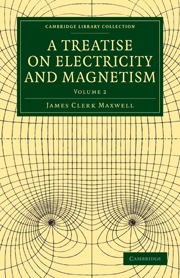Book contents
- Frontmatter
- Contents
- PART III MAGNETISM
- CHAPTER I ELEMENTARY THEORY OF MAGNETISM
- CHAPTER II MAGNETIC FORCE AND MAGNETIC INDUCTION
- CHAPTER III PARTICULAR FORMS OF MAGNETS
- CHAPTER IV INDUCED MAGNETIZATION
- CHAPTER V MAGNETIC PROBLEMS
- CHAPTER VI WEBER'S THEORY OF MAGNETIC INDUCTION
- CHAPTER VII MAGNETIC MEASUREMENTS
- CHAPTER VIII TERRESTRIAL MAGNETISM
- PART IV ELECTROMAGNETISM
- INDEX
- Plate section
CHAPTER IV - INDUCED MAGNETIZATION
Published online by Cambridge University Press: 05 July 2011
- Frontmatter
- Contents
- PART III MAGNETISM
- CHAPTER I ELEMENTARY THEORY OF MAGNETISM
- CHAPTER II MAGNETIC FORCE AND MAGNETIC INDUCTION
- CHAPTER III PARTICULAR FORMS OF MAGNETS
- CHAPTER IV INDUCED MAGNETIZATION
- CHAPTER V MAGNETIC PROBLEMS
- CHAPTER VI WEBER'S THEORY OF MAGNETIC INDUCTION
- CHAPTER VII MAGNETIC MEASUREMENTS
- CHAPTER VIII TERRESTRIAL MAGNETISM
- PART IV ELECTROMAGNETISM
- INDEX
- Plate section
Summary
424.] We have hitherto considered the actual distribution of magnetization in a magnet as given explicitly among the data of the investigation. We have not made any assumption as to whether this magnetization is permanent or temporary, except in those parts of our reasoning in which we have supposed the magnet broken up into small portions, or small portions removed from the magnet in such a way as not to alter the magnetization of any part.
We have now to consider the magnetization of bodies with respect to the mode in which it may be produced and changed. A bar of iron held parallel to the direction of the earth's magnetic force is found to become magnetic, with its poles turned the opposite way from those of the earth, or the same way as those of a compass needle in stable equilibrium.
Any piece of soft iron placed in a magnetic field is found to exhibit magnetic properties. If it be placed in a part of the field where the magnetic force is great, as between the poles of a horse-shoe magnet, the magnetism of the iron becomes intense. If the iron is removed from the magnetic field, its magnetic properties are greatly weakened or disappear entirely. If the magnetic properties of the iron depend entirely on the magnetic force of the field in which it is placed, and vanish when it is removed from the field, it is called Soft iron.
- Type
- Chapter
- Information
- A Treatise on Electricity and Magnetism , pp. 44 - 55Publisher: Cambridge University PressPrint publication year: 2010First published in: 1873



